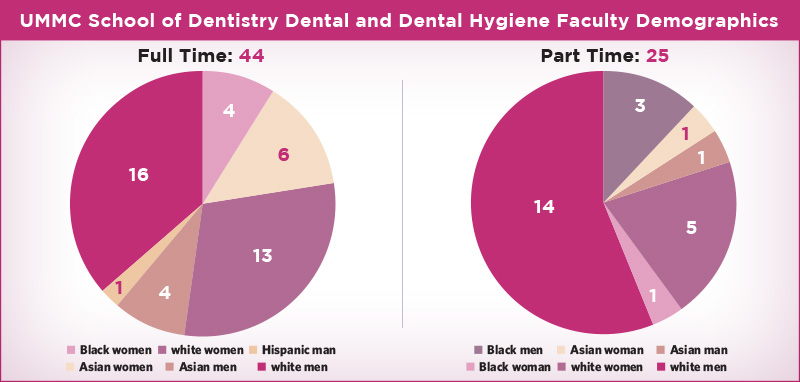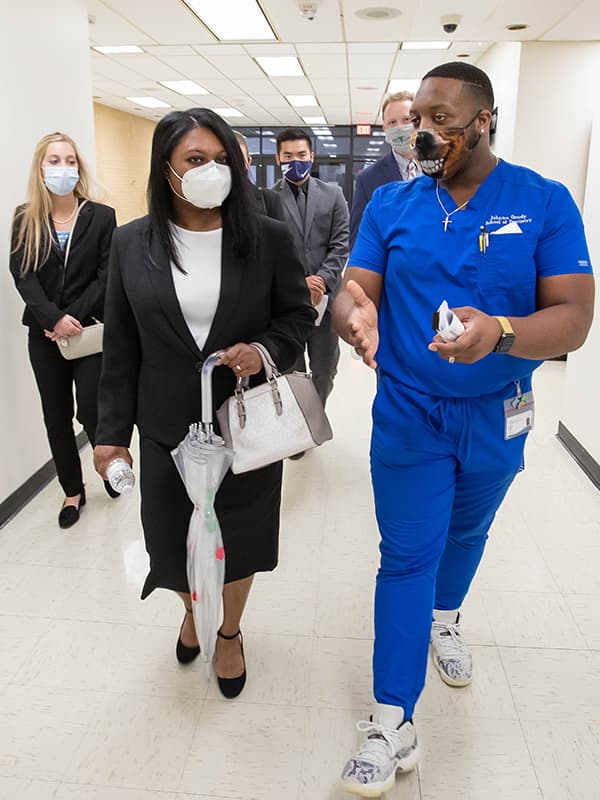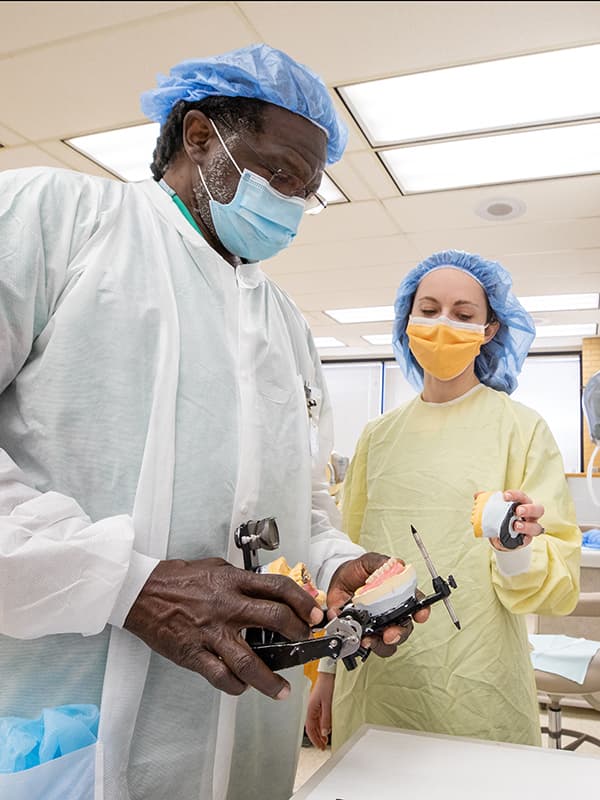Diversity, equity, inclusion: it’s part of the culture

Note: This article originally appeared in the Winter 2022 issue of UMMC Dentistry, the annual magazine for the University of Mississippi Medical Center School of Dentistry.
Mississippi’s sole School of Dentistry is doing something different – profoundly and ambitiously – to create a space for teaching and learning that mirrors the state. It calls for making diversity, equity and inclusion a part of the culture.
“Whatever we’ve been doing has not produced the results you’d like to see,” said Dr. William Boteler, an associate professor in Care Planning and Restorative Sciences.
New dean Dr. Sreenivas Koka has assembled a first-time Admissions Board of Directors to take on a necessary challenge: attract a faculty and student body that is inclusive and better reflects Mississippi’s demographics. They’re taking a holistic approach to recruiting stellar students, and at the same time, taking into account the whole person and their potential to deliver compassionate oral care.
“It’s about representation on all levels. We’re not just talking about ethnicity,” said Dr. Kristin Nalls, director of Admissions and the new assistant dean of Student Affairs and Inclusion. “We’re talking about gender, socioeconomic status, age, the area of the state where you’re from.
“The Board of Directors has worked diligently to create a holistic admissions process that limits bias, and gives every applicant equal care and attention during application screening and the interview process. Our goal is to ensure an equitable experience for each applicant.”
School of Dentistry leaders say that holistic approach to admissions can be accomplished without sacrificing excellence in education. The mission is to admit students capable of passing licensing examinations and practicing the highest quality dentistry.

The work areas are clear.
For the 2020-21 academic year, the 158-strong dental student body includes 14 Black students and 20 students of races other than white or Black.
About 20 percent of the SOD full-time and 34 percent of part-time faculty are minorities. “Our state does not look like that,” Nalls said. U.S. Census data show that the state’s white alone population in 2019 stood at 56.4 percent; Black or African American alone population, 37.8 percent; and other races, a total 5.8 percent.
Nalls is leading the four-member Admissions Board of Directors charged with overseeing the recruitment and admissions process. The others are Boteler; Dr. Alexa Lampkin (‘17), assistant professor in the Department of Care Planning and Restorative Sciences; and Dr. Yuanyuan Duan, associate professor in the Department of Biomedical Materials Science.
Working closely with the admissions directors will be a related team focusing on diversity and inclusion initiatives within the SOD. Nalls is joined on that team by education administrator Sandra Johnston and administrative assistant Rochelle Anthony, both employees in Student Affairs and Inclusion.
“Dr. Koka is leading the charge to change the culture here so that we can attract more minority candidates and have strategic people in place at the SOD to show students we are invested in diversity and representation,” Nalls said.

Dr. Deepti Janorkar, left, a School of Dentistry faculty member, instructs first-year dental resident Dr. Graham Garvey (‘21) as they treat Kelsey Kilpatrick of Grenada in the school’s Jackson Medical Mall dental clinic.
“Actions speak louder than words, and the best chance we have of our graduates practicing in underserved areas in Mississippi is to admit those who have a sustained and sincere track record of serving the underserved,” Koka said.
“I have asked our admissions team to give a higher priority to applicants who have this track record, and to work toward our school’s student body looking like our state. I thank them for undertaking this important journey, and I recognize it is a process that will take time to do properly.”
They’ve identified the challenges, Now, they’re focused on finding and implementing the solutions.
— — —
The SOD only accepts applicants who are Mississippi residents. “All of us are in agreement that the population of the dental student classes should reflect the population of the state of Mississippi,” Boteler said. “And it doesn’t at the present time.”
Boteler has a special calling to recruit Black male students and those from underrepresented backgrounds. “The emphasis I feel in my heart includes Asian, American Indian, Hispanic students ...all minorities that are just not represented,” Boteler said.
“A lot of young minority males haven’t seen a minority male dentist in their life. They don’t have a dentist role model to follow,” he said. “Some of us from a different culture don’t know how important that is: to see themselves as a dentist, and then to go to dental school.”
Building interest in dentistry as a career, though, isn’t enough.
“Schools scramble for a diverse student body, so they take our students,” Boteler said. “Some of them have few minority students in their population, and some other schools give them a full ride. It makes it difficult for us to compete.
“We need to find out what is drawing our candidates away, and we need to get in the game and compete for them, a lot like
college athletic recruiting. There are a lot of young men out there, and we need to do a better job of identifying them early.”
“We want the workforce we produce to represent every area of Mississippi, and we want our applicant pool and faculty to look like Mississippi,” Nalls said.
That’s also the mantra of Dr. Leon Anderson (‘85), a longtime Jackson dentist who joined the faculty after graduating from the SOD in 1985, serving first as assistant director of the
general practice residency program in Care Planning and Restorative Sciences, then as the Medical Center’s Division of Multicultural Affairs director from 1989-2002.

School of Dentistry Ambassador and second-year student Johntre Goudy talks with applicant Kierra Banks as fellow applicants, from left, Aubree Dillon, Jay Fritts and Dutton Day listen in.
The SOD in summer 2021 created four named development funds, each focusing on an area of need. The Leon Anderson Jr. DMD Diversity and Inclusion Fund will help make it possible for more underrepresented and disadvantaged students to earn their dental degrees and practice in Mississippi.
“People tend to want to go where people who look like them are. That should not be a problem. This state is 36 or 37 percent underrepresented minorities,” Anderson said. “If you have more people on the faculty that mirror the state itself, the students are going to be more comfortable, and more likely to come here.
“We’ve heard this over and over again: we need to recruit, and we can’t recruit people of color. At this time, what’s encouraging to me is that we’ve stopped talking, and we’ve implemented a program to do this. We’re putting forth the effort.”
When Lampkin joined the SOD faculty in 2018, the year after finishing her studies there, “I was the only African-American faculty member for approximately two and a half years,” she said.
She wants the school’s applicant pool to include candidates who have “the heart of a servant.”
“I’d rather have someone treat me with the heart of a servant who can relate and talk to me than someone who is extremely intelligent, not personable and lacks good bedside manner,” Lampkin said. “There’s an oral cavity attached to a person, but you’ve got to treat the person.
“No patient is going to ask you what your GPA was in dental school,” she said. “A Dental Admissions Test score does not reflect the capability of a student or the prospective success of a student in and out of the classroom. We’re trying to give everyone a fair chance to prove themselves.”
— — —
The external challenges to recruiting and retaining faculty are perennial and daunting, but the SOD teams are working to turn some of them on their ear.
“We’re competing with everyone for dental school faculty,” Nalls said. “Mississippi is a hard place, sometimes, to sell. We are rural. We are the only dental school in the state, and sometimes that can be a challenge.
“But, what we see is that in some instances what looks like a barrier, to the right candidates, can actually be an incentive. It’s all about mindset.

Dr. Joann Travis, left, a faculty member who practices at the G.V. “Sonny” Montgomery Veterans Affairs Medical Center, reviews the record of a patient in the Restorative Clinic with fourth-year student Stan Tristeza before hebegins treatment.
“We can say that we are a small school where people can effect change and be on the front lines to do something important, and that we are trying to change our culture to one that empowers faculty to seek change.”
Simply because it’s in Mississippi, the SOD must defend itself against negativity about the state’s history. “We are pushing against stereotypes and people’s past perceptions,” Nalls said. “I’m asking people to focus on the paradigm shift that is happening. The SOD is not the same.”
Lampkin believes the attraction of a lucrative private practice,
or the perception that will be the case, impacts career
decisions of young dentists. The focus might be on “ensuring an adequate income level to sustain one’s lifestyle,” Lampkin said.
Why not be in private practice and still teach SOD students?
“A viable option could be working part-time in a private practice while serving as a full-time faculty member, or vice versa. The SOD has part-time and adjunct faculty members who work a couple of days a week with students in our clinic,” Lampkin said. “Sometimes, it requires a unique balance.”
It’s important to remember that diversity in faculty and the student body go hand in hand, Duan said.
“By having a more diverse faculty, we will be in a better position to attract and recruit high-quality candidates from diverse backgrounds, and we will be able to develop more effective methods for the recruiting process,” Duan said.
— — —
Boteler’s service with the SOD already involved being a screener for the student admissions process, with various committees scoring an applicant based on GPA and DAT performance, personal statement and record of community service.
That process is getting a fresh look.
“Dr. Koka doesn’t want us to miss the students who might not have the strongest academics, but who are still exceptionally well qualified and would make a good dentist,” Boteler said.
The fall 2022 D1 class will be chosen based in part on something new: multiple mini-interviews with applicants, or MMI, will make up an additional score. “That’s when the four directors look at the overall package,” Boteler said. It’s not a new concept, just new to the SOD.
“The medical schools say they’d never go back to the traditional interview,” Boteler said.
The MMIs took place in September 2021. How it worked: Prospective SOD students were interviewed in groups of 20 at the School of Medicine. Ten stations were set up in hallways, and the first 10 candidates each stood at a station and had two minutes to read a question posing an ethical dilemma. Then, each entered a room by their station staffed by two interviewers. The candidate had eight minutes to present their solution to the scenario.

Dr. Alvin Rembert, a faculty member in the School of Dentistry who practices at the G.V. “Sonny” Montgomery Veterans Affairs Medical Center, discusses a mold of a patient’s teeth with fourth-year student Christina Legradi in the Restorative Clinic.
“They’ll be scored and then move on to the next room,” rotating to a total 10 rooms, Boteler said. “It’s not the traditional ‘Tell us about yourself’ interview.”
The new School of Medicine, which opened in 2017, is more practical for interviews than the aging School of Dentistry, which enrolled its first class in 1975. “They were very forthcoming in accommodating us in the interview process,” Nalls said of SOM leaders including Dr. Loretta Jackson-Williams, vice dean for medical education, and Dr. Demondes Haynes, associate dean for admissions.
“We were blown away by the quality of the candidates, Boteler said. “For almost every one, our jaws were on the floor. We were asking tough questions.”
SOD student ambassadors also gave candidates tours of the school. That diverse 23-member group plays a key role in recruitment of students, Lampkin said. “They’ll work with Student Affairs and current students, and engage SOD alums in our efforts. It’s going to be fun. They have a big task ahead of them.”
“The four of us feel like this is our charge,” Boteler said. “We want to admit the most highly qualified students we can find, but to be mindful of inequities that have been there a long time. Mississippi can be a leader here in innovation. We just need to go about it a little differently than before.”
The next steps to diversity within dental class cohorts, Nalls said, is to engage with underrepresented groups at undergraduate institutions and secondary educational systems, and to reach out to other groups of interest to promote careers in dentistry and exposure to the program.
“We want to have a pathway to admission that is fair and efficient, and to also create an applicant pool that will fully represent our state,” she said. “We’re definitely working with strengthening relationships between the dental school and minority alumni. We are reaching out to the Mississippi Dental Society, a minority group, on solidifying a mentorship program. Those dentists will be on campus and in our clinics and will try to recruit faculty.”
“We’re not where we need to be, but we’re definitely moving in the right direction,” Lampkin said. “A lot of the traditional mindsets are starting to dissipate. We are trying to be more relatable to students. The challenge has been trying to reach HBCUs. However, through our outreach efforts, I am confident we will see application numbers increase from students of diverse backgrounds.
“We want to create some pipelines with the Jackson school district. We have so many ideas to bring about a warmer cultural climate at the SOD, and the SOD ambassador program will be a tool for accomplishing this mission.”
The four years spent educating a stellar, diverse group of students is just one part of the challenge. “Our charge and mission is to create a diverse workforce that affects change and reduces oral health disparities,” Nalls said. “We need to go back and find the students who go out of state to practice, and we need to reach out to the Mississippi students who are getting their education at a different dental school.”
Duan’s reasoning for saying yes to the Admissions Board is shared by the rest of the team: She’s passionate about the school where she was trained. “I want to make more of a contribution to its goals and missions,” Duan said.
The school’s students, faculty and staff “are better able to care for all Mississippians if we can appreciate their diverse needs, hopes, fears, expectations and aspirations,” Koka said.
“We are making intentional efforts to make sure students know that they are valued and loved,” Nalls said. “We want them to thrive. We want them to say they love it here.”


